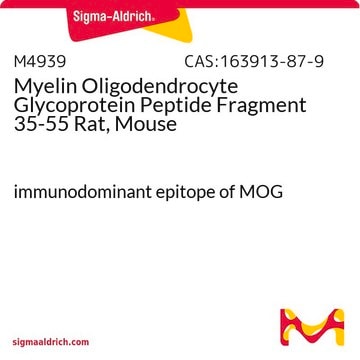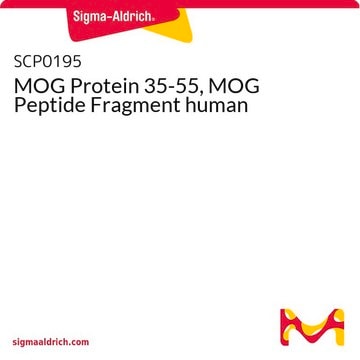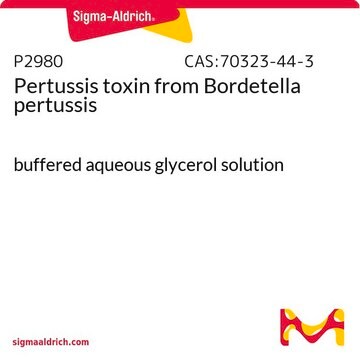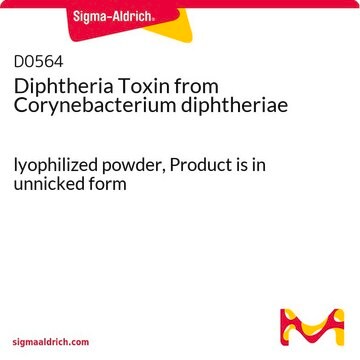516852
Pertussis Toxin, B Oligomer, Bordetella pertussis - Calbiochem
Sign Into View Organizational & Contract Pricing
All Photos(1)
About This Item
Recommended Products
form
lyophilized
impurities
≤1% holotoxin (by CHO cell assay)
solubility
aqueous buffer: soluble
sterile distilled water: soluble
General description
The pentameric cell-binding component that is responsible for binding of the holotoxin to eukaryotic cell surfaces, facilitating entry of the A protomer into receptive cells. Reported to elicit direct cellular responses by binding to several cell surface receptors with oligosaccharide side chains. Also elicits a variety of physiological responses, such as mitogenesis in human T cells, enhancement of aggregation of human platelets, elevation of cytosolic Ca2+ levels, and neutralization of antibody response in mice. Reported to deactivate CCR5 and inhibit the entry of R5 HIV-1 in activated T lymphocytes. Also blocks post-entry step of HIV-1 replication.
Biochem/physiol Actions
Cell surface receptors with oligosaccharide side chains
Reconstitution
Following reconstitution, refrigerate (4°C). Stock solutions, prepared from high ionic strength buffers, are stable for up to 3 months at 4°C.
Analysis Note
Four distinct bands by SDS-PAGE
Certificates of Analysis (COA)
Search for Certificates of Analysis (COA) by entering the products Lot/Batch Number. Lot and Batch Numbers can be found on a product’s label following the words ‘Lot’ or ‘Batch’.
Already Own This Product?
Find documentation for the products that you have recently purchased in the Document Library.
D L Burns et al.
Infection and immunity, 55(1), 24-28 (1987-01-01)
The mechanism by which pertussis toxin induces morphological changes in Chinese hamster ovary cells was studied to determine whether the resulting clustered growth pattern is due to toxin-catalyzed ADP-ribosylation of a cellular substrate. While pertussis toxin was extremely potent in
E L Hewlett et al.
Infection and immunity, 40(3), 1198-1203 (1983-06-01)
Exposing Chinese hamster ovary cells in culture to pertussis toxin resulted in a novel clustered growth pattern. The specificity of the response for pertussis toxin was shown by neutralization of the activity with specific anti-toxin antibody, heat lability (80 degrees
W S Wong et al.
Canadian journal of physiology and pharmacology, 74(5), 559-564 (1996-05-01)
Pertussis toxin (PTX) is a heterohexameric protein, which is divided into subunits A and B. The A-subunit (protomer) possesses adenine diphosphate (ADP) ribosyltransferase activity, and the B-oligomer confers cell surface binding specificity on the toxin. By virtue of the ADP-ribosylation
M Alfano et al.
Journal of virology, 74(18), 8767-8770 (2000-08-23)
We have recently demonstrated that the binding subunit (B-oligomer) of pertussis toxin (PTX-B) deactivates CCR5 and inhibits entry of R5 human immunodeficiency virus type 1 (HIV-1) strains in activated primary T lymphocytes (M. Alfano et al., J. Exp. Med. 190:597-605
M Tamura et al.
Biochemistry, 21(22), 5516-5522 (1982-10-26)
The subunit structure of islet-activating protein (IAP), pertussis toxin, has been analyzed to study a possibility that this protein is one of the A-B toxins [Gill, D. M. (1978) in Bacterial Toxins and Cell Membranes (Jeljaszewicz, J., & Wadstrom, T.
Our team of scientists has experience in all areas of research including Life Science, Material Science, Chemical Synthesis, Chromatography, Analytical and many others.
Contact Technical Service





